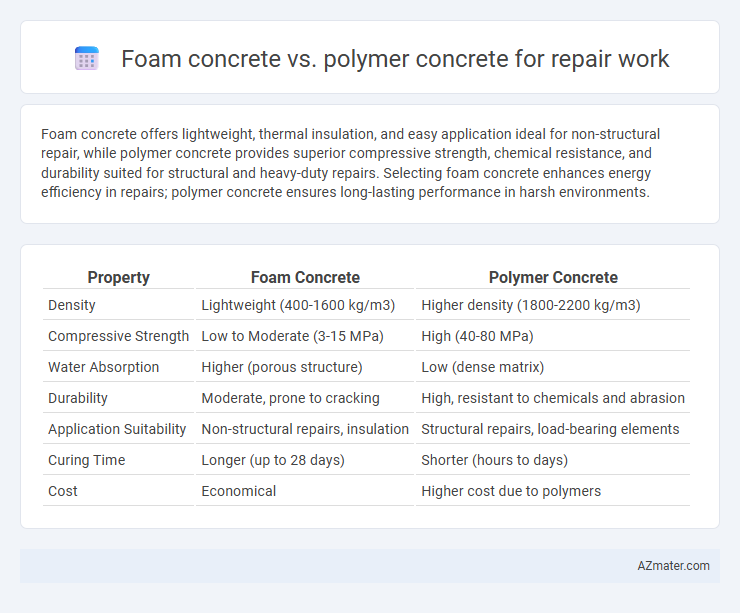Foam concrete offers lightweight, thermal insulation, and easy application ideal for non-structural repair, while polymer concrete provides superior compressive strength, chemical resistance, and durability suited for structural and heavy-duty repairs. Selecting foam concrete enhances energy efficiency in repairs; polymer concrete ensures long-lasting performance in harsh environments.
Table of Comparison
| Property | Foam Concrete | Polymer Concrete |
|---|---|---|
| Density | Lightweight (400-1600 kg/m3) | Higher density (1800-2200 kg/m3) |
| Compressive Strength | Low to Moderate (3-15 MPa) | High (40-80 MPa) |
| Water Absorption | Higher (porous structure) | Low (dense matrix) |
| Durability | Moderate, prone to cracking | High, resistant to chemicals and abrasion |
| Application Suitability | Non-structural repairs, insulation | Structural repairs, load-bearing elements |
| Curing Time | Longer (up to 28 days) | Shorter (hours to days) |
| Cost | Economical | Higher cost due to polymers |
Introduction to Foam Concrete and Polymer Concrete
Foam concrete is a lightweight, cellular material created by combining cement, water, and a foaming agent, resulting in excellent thermal insulation and reduced self-weight ideal for repair work on non-structural elements. Polymer concrete, reinforced with synthetic resins such as epoxy or polyester, offers superior chemical resistance, adhesion, and mechanical strength, making it highly suitable for repairing structural components exposed to harsh environments. Both materials serve distinct functions in repair applications, with foam concrete excelling in insulation and void filling, while polymer concrete provides durable, high-strength restoration.
Material Composition and Properties
Foam concrete consists primarily of cement, water, and air bubbles created by a foaming agent, resulting in a lightweight and low-density material with excellent thermal insulation and fire resistance but reduced compressive strength. Polymer concrete is composed of aggregates bound by polymer resins like epoxy or polyester, offering superior chemical resistance, high tensile strength, and enhanced adhesion for repair applications. Foam concrete suits non-structural repair with emphasis on insulation, while polymer concrete excels in structural repairs demanding durability and resistance to harsh environmental conditions.
Strength Characteristics Comparison
Foam concrete exhibits lower compressive strength typically ranging between 1.5 to 10 MPa, making it suitable for lightweight, non-structural repairs, whereas polymer concrete offers significantly higher compressive strengths often exceeding 40 MPa, ideal for structural restoration. Polymer concrete's superior strength is attributed to its resin binder, providing enhanced chemical resistance and durability compared to the cementitious matrix in foam concrete. The choice between foam and polymer concrete for repair hinges on load-bearing requirements and environmental exposure, with polymer concrete preferred for high-strength, long-lasting repairs.
Durability in Repair Applications
Polymer concrete offers superior durability in repair applications due to its excellent chemical resistance, high compressive strength, and low permeability, making it ideal for environments exposed to harsh chemicals and moisture. Foam concrete, while lightweight and easy to apply, generally exhibits lower strength and higher porosity, which can reduce its lifespan in high-stress or chemically aggressive conditions. For long-term repairs requiring resistance to cracking, abrasion, and environmental degradation, polymer concrete provides a more robust and reliable solution.
Workability and Ease of Application
Foam concrete offers superior workability due to its lightweight and flowable nature, making it ideal for filling large voids and uneven surfaces quickly. Polymer concrete provides enhanced adhesion and rapid curing times, which improve ease of application for precise repairs and structural bonding. Both materials excel in repair work, but foam concrete is preferred for its ease in handling and shaping, while polymer concrete is favored when durability and chemical resistance are critical.
Cost Analysis: Foam vs Polymer Concrete
Foam concrete offers a cost-effective solution for repair work due to its lightweight nature and lower material expenses compared to polymer concrete. Polymer concrete, although more expensive upfront, provides superior durability and chemical resistance, resulting in lower maintenance and longer service life. Evaluating total lifecycle costs, foam concrete is ideal for budget-sensitive projects, while polymer concrete suits applications demanding high performance and longevity.
Environmental Impact and Sustainability
Foam concrete offers significant environmental benefits due to its lightweight nature, low energy consumption during production, and high thermal insulation properties, leading to reduced carbon emissions over its lifecycle. Polymer concrete, while providing superior durability and chemical resistance in repair applications, relies heavily on non-renewable petroleum-based resins, which increases its environmental footprint and challenges sustainability goals. Selecting foam concrete for repair work aligns better with green construction practices and contributes to long-term sustainability through energy efficiency and reduced resource depletion.
Typical Repair Work Use Cases
Foam concrete is ideal for lightweight void filling, thermal insulation, and non-structural repairs due to its low density and excellent workability, making it suitable for floor leveling and roof repairs. Polymer concrete offers superior chemical resistance, high compressive strength, and rapid curing, making it the preferred choice for structural repairs, trench reinstatement, and eroded concrete patching in aggressive environments. Repair work involving heavy load-bearing areas or exposure to chemicals benefits significantly from polymer concrete's durability, while foam concrete excels in insulation and filling applications where weight reduction is critical.
Limitations and Challenges
Foam concrete exhibits lower compressive strength and poor resistance to chemical attacks, limiting its use in heavy-load repair applications and durable environments. Polymer concrete faces challenges like high material costs and sensitivity to UV degradation, which can affect long-term performance in outdoor repairs. Both materials require careful consideration of environmental conditions and load requirements to avoid premature failure in repair projects.
Choosing the Right Concrete for Your Repair Project
Foam concrete offers excellent thermal insulation and lightweight properties, making it ideal for non-structural repairs and void filling, whereas polymer concrete provides superior chemical resistance and high mechanical strength suited for structural repairs exposed to harsh environments. Understanding the project's load-bearing requirements and environmental conditions is crucial when selecting between foam concrete's ease of application and polymer concrete's durability. Evaluating factors such as curing time, bond strength, and exposure to chemicals ensures optimal repair performance and longevity.

Infographic: Foam concrete vs Polymer concrete for Repair work
 azmater.com
azmater.com